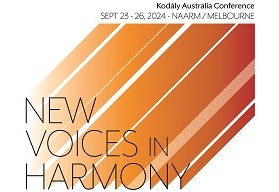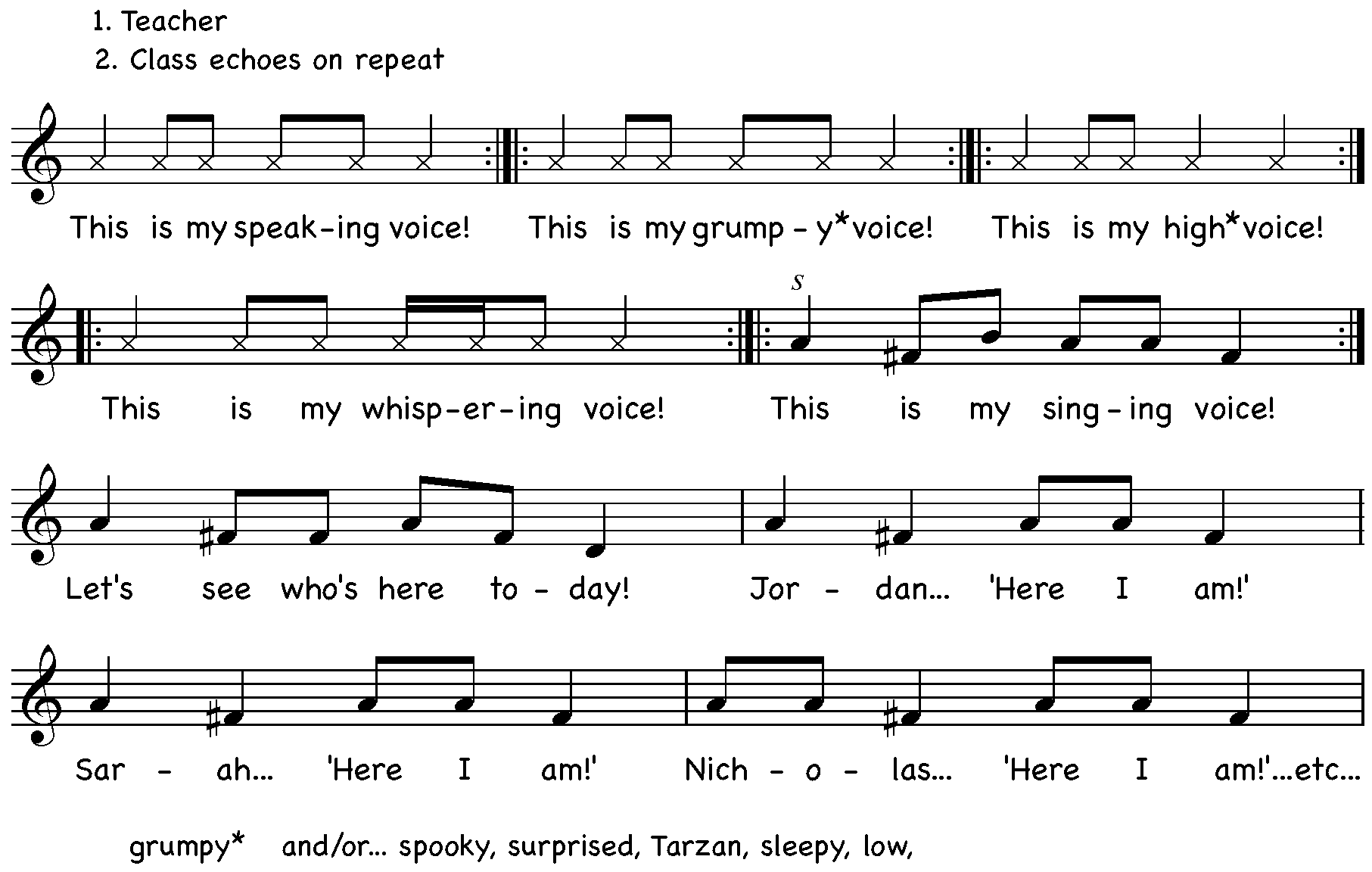Julia Piggin
Learning names in Prep
- Move from speaking voice to singing voice
- Sit in circle, feel the beat with silent tapping on knees
- Also use for anecdotal assessment of beat, intonation, vocal quality (potential modeling), vocal health (be alert to any huskiness)
- Encourage attentive listening by always asking for class feedback
– T: ‘James, whose singing voice did you enjoy today?
- Another option is the bitonal song…
– ‘Bee, bee, bumble bee, can you sing your name for me?’
– And any other so-mi phrases, such as…’Jordan, where are you? Jordan I see you!’
- Later, discover how many claps in students’ names and create groupings:
– T: ‘Stand up if I clap your name.’ (one clap = Max, Bill, Sue, etc…)
Learning names in Year One
- It’s a good idea to ensure that everyone has the opportunity to learn names in the first week of a school year! (classes have been mixed up)
- Sit together on the floor in circle formation
- Put each child’s name and favourite food into this chant
- ‘Stephen’ also keeps the beat on claves…everyone else taps along using finger sticks
- Assess individual beat-keeping skills with date (record score out of 5 for example)
- Make sure to invite feedback by asking questions when appropriate such as… ‘What did you notice about the way Stephen kept the beat?’…
- Always listen to a variety of responses, thereby engaging the group rather than one student in the process
- Remember that children learn most effectively from observing each other
- The class could also learn more about you… ‘Delicious! I love cherries too!’
References for similar material:
John Foster and Carol Thompson, First Verses, OUP, 1996.
Compiled by Elizabeth Matterson, This Little Puffin…, Puffin Books, revised edition 1991.
Using names in Year Two
‘Grandpa Moses’
- Standing circle with Grandpa/Grandma in the middle
- Actions: side pat-a-cake claps, then shake it!
- Grandpa Moses can become Grandpa Alex or Grandma Veronica for example…
- Grandpa/Grandma of course has to shimmy those hips…and on ‘Get out of (outta) town’, chooses the next one to be in the middle
- There is another ‘cool cat’ version of this rhyme, with the lines…
- ‘Let’s get the rhythm of the head….ding, dong!
We’ve got the rhythm of the head….ding, dong!
…
Playing around with names in the Middle Primary years…
‘A’ my name is Abbie
- An adaptation of a traditional American folk-song…a sort of cut and paste!
- I have replaced the slightly awkward traditional categories with…a pet’s name (rather than a wife or husband’s), and anything you like (doesn’t have to be in a basket)
- Each verse is sung twice, once by the creator and then repeated by the class
- This provides an opportunity for each child to hear his own voice and the voices of those around him
- You can later upgrade your anecdotal notes
- Some ideas:
A my name is Alex
My dog’s name is Arthur
We come from Ararat
And we like anteaters.
F my name is Fiona,
My cat’s name is Fuzzy
We come from Florence
And we like figs.
- If possible, record the text of each child’s verse…you may find a creative way to use it later in the year!
- Create your own verse, so that the children know your name too
Telephone Song
- Call and response
- ‘Charlie’ has three phrases, the third being used to ‘call in’ the next soloist
- Add a body percussion accompaniment…slap/click style
Upper Primary
Listen to a recording of Benjamin Britten’s A New Year Carol from Friday Afternoons
http://www.naxosmusiclibrary.com/catalogue/item.asp?cid=8.553183#
- Discuss the text (From ‘Tom Tiddler’s Ground’ – Walter de la Mare)
Please note the following:
Copyright 1936 by Boosey & Co., Ltd. Copyright renewed.
Copyright for all countries. All rights reserved.
- Consider the ensemble and the performance
- Ask questions: How many verses? How many choruses? Are all choruses the same? Unison or part-singing?
- Talk about the style of language…old English…and the historical context
- Discover the metre
- Revise 3 metre
- Take rhythmic dictations from the phrases
- Analyse the score
- Listen again
- Learn the song, develop the tone, shape the phrases, enjoy the piano accompaniment
- There is still more to do….
A useful reference:
Mary Goetze, Angela Broeker and Ruth Boshkoff, Educating Young Singers, mjpublishing.com, 2011.
———-
With many years experience in music education, Julia has focused in more recent times on the challenges of engaging primary-age boys in music through her position at Scotch College, Melbourne. She is the author of the teaching resource ‘From Sound to Symbol’ and presents courses and workshops on Kodály teaching techniques around Australia.









